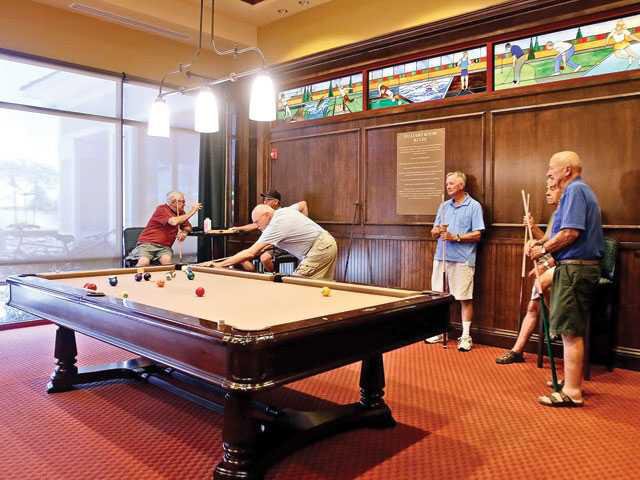Spreckels Sugar in the 1950s paid its employees one week in $2 bills.
The goal was to show the Manteca community just how important the sugar refinery was to the local economy.
The result surprised merchants and residents alike as $2 bills quickly filled up cash registers around Manteca.
If Del Webb at Woodbridge residents spent only $2 bills at Manteca businesses and services for a week, the impact of the age-restricted community (at least one spouse has to be 55 years or older) on the local economy would become apparent.
Residents in Del Webb at Woodbridge typically have household incomes higher than the median for Manteca overall of $55,563 whether they are still working or living off retirement accounts, pensions, and investments.
“Del Webb was a great move,” noted former Manteca Planning Commission member and Realtor Tom Wilson. “They have had a real big impact on stores and the economy.”
But perhaps Del Webb’s biggest impact on Manteca took place during the dark days of the Great Recession.
The first full year of sales was 2006 just as the housing meltdown hit.
Pulte Homes — the developer of Del Webb — along with Bass Pro Shops and Costco may have had bad timing from their perspective by starting sales just as the recession hit, but for Manteca it couldn’t have happened at a more opportune time.
All three played a big role in the city actually being able to increase sales taxes for the first two years of the recession while nearby cities were in retreat. Bass Pro drew in 2.8 million fairly well-to-do customers from as far away as San Jose, Fresno, and San Francisco to spend large sums of money.
Meanwhile the household that Del Webb added to Manteca helped struggling stores and other businesses by buying goods and services. That in turn helped save jobs. The addition of new homes also reduced the property tax slide in back-to-back years compared to nearby cities that did not have any new home construction to speak of to offset market values being adjusted downward by foreclosures.
Del Webb’s biggest impact on Manteca’s economy was through the impact of home sales.
For four years, Manteca developers built and sold right around 300 homes a year. That was more than the combined total of every city in San Joaquin, Stanislaus and Merced counties. And of those 300 homes each year roughly a third or more were Del Webb.
Actually, Del Webb could be credited with being responsible for up to half of all new home sales during that time. Atherton Homes sales staff noted during the recession that a large share of their homes were bought by people who looked at Del Webb but weren’t thrilled with restrictive neighborhood rules or else were purchased by the grown children of new Del Webb residents who fell in love with Manteca and also decided to move from the Bay Area to Manteca. Most of the Del Webb residents in the early going hailed from the Bay Area.
The Del Webb effect was also true for the other Union Ranch East builder — Woodside Homes.
“Del Webb had a direct impact on home sales,” Wilson noted. “They were key in keeping new home sales going.”
That meant construction crews working. It also helped loan officers, various real estate inspectors, home improvement firms, furniture stores and others that depend on home sales to generate business.
Del Webb is perhaps the only newer neighborhood in Manteca today where some existing homes sell for more on the resale market than similar sized new models. It speaks to the value of the Del Webb product and the firm’s strategy at targeting a niche homebuyer segment.
An economic overview of the spending habits of residents in other Del Webb communities that was provided during the approval process for the 1,422-home project on 355 acres northwest of Lathrop and Union roads showed those who live in the age restricted community dined out more often than the general population as a whole, traveled more, spent more on leisure activities, and even frequented hair salons more often.
And unlike conventional subdivisions, Del Webb does not impact the schools.
Pulte Homes searches out vibrant communities that have services, shopping, amenities, and desirable locations. Back in 2005 Pulte Homes’ top brass openly admitted they were surprised when a survey of Bay Area residents 55 and over gave Manteca the highest marks by far as to where they’d like to see a Del Webb community located.
Del Webb purposely picks communities with low crime rates and other key amenities.
John Johnson, Pulte Home’s Vice President of Land for the Northern California Division when Del Webb was moving through the approval process in Manteca noted an economic study by the firm showed Del Webb residents dine out more, patronize cultural events more and access services such as hair styling more than the typical household.
“If I were a smart businessman, I’d have a styling salon set up and ready to go as close as I can get to Del Webb,” Johnson said in 2005. “They (stylists) really benefit.”
Weekly trips to the hair stylist aren’t the norm for most households. Del Webb residents can do that because they have disposable income and lots of it. It isn’t unusual for the majority of Del Webb buyers to pay cash for their homes. That means no mortgage payments which in turn mean more disposable income.




